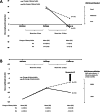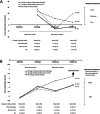Nutritional education during rehabilitation of children 6-24 months with acute malnutrition, under unavailability of therapeutic/supplementary foods: a retrospective study in rural Angola
- PMID: 33627083
- PMCID: PMC7903716
- DOI: 10.1186/s12887-021-02560-z
Nutritional education during rehabilitation of children 6-24 months with acute malnutrition, under unavailability of therapeutic/supplementary foods: a retrospective study in rural Angola
Abstract
Background: Dietary counseling can play an important role in managing child malnutrition but is often inadequate or absent. Moreover, little emphasis is given to the usefulness of local available foods in the rehabilitation of malnourished children. This study aimed to evaluate the adherence and effectiveness of nutritional education during rehabilitation of children (6-24 months) with acute malnutrition, in a setting of unavailability of therapeutic/supplementary foods.
Methods: Retrospective observational study on the adherence to dietary counseling and the impact on growth in children 6-24 months who were referred for acute malnutrition at the Catholic Mission Hospital of Chiulo (Angola) from August 2018 to January 2019. Main outcome measures were change in dietary habits and growth gain.
Results: Sixty-four out of 120 children returned at first follow-up visit (default rate 47%). A change in dietary habits was reported in 32/64 (50%) children. Changing dietary habits was associated with an improved change in weight gain (MD 9.3 g/kg/day, 95%CI 4.2 to 14.3; p = 0.0005) and in weight/height ratio (MD 1.1 SD, 95%CI 0.7 to 1.4; p < 0.0001).
Conclusions: A change in dietary habits after discharge was noted in only half of the patients who returned at first follow up visit, but it provided some advantages in term of weight gain and weight/height ratio. Further studies are needed to identify children at risk of low adherence to follow-up visits and low compliance to the nutritional recommendations, in order to increase the effectiveness of rehabilitation programs.
Keywords: Acute malnutrition; Education; Nutritional rehabilitation.
Conflict of interest statement
The authors declare no conflict of interest.
Figures
References
-
- UNICEF/WHO/The World Bank Group Joint child malnutrition estimates. Levels and trends in child malnutrition, 2018 edition.
-
- Ashworth A. Nutrition, Food Security, and Health, Chapter 46. In: Kliegman RM, Stanton BMD, St. Geme J, Schor NF, editors. Nelson Textbook of Pediatrics. 20th ed: Elsevier Health Sciences; 2015.
-
- FAO; IFAD; UNICEF; WFP; WHO . The State of Food Security and Nutrition in the World 2018. Building climate resilience for food security and nutrition. 2018.
-
- UNICEF . The state of the World’s children 2019. Children, Food and Nutrition: Growing well in a changing world. 2019.
Publication types
MeSH terms
LinkOut - more resources
Full Text Sources
Other Literature Sources
Medical




